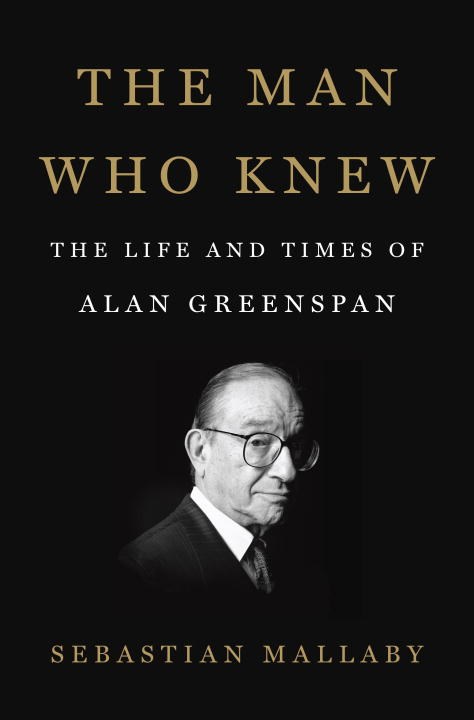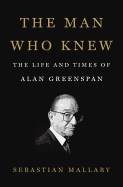The Man Who Knew: The Life and Times of Alan Greenspan
October 14, 2016
Sebastian Mallaby has written a complete portrait of the most important and influential economic statesmen of our time.

The Man Who Knew: The Life and Times of Alan Greenspan by Sebastian Mallaby, Penguin Press, 800 pages, $40.00, Hardcover, October 2016, ISBN 9781594204845
Alan Greenspan, the Chairman of the Federal Reserve for almost two decades, under four different presidents, once called the creation of the Federal Reserve “one of the historic disasters in American history.”
A man who was laudingly referred to as “the maestro” for his mastery of the economy as head of the national bank, he began his political life a laissez-faire libertarian who argued vociferously that government involvement in the economy is an affront to the natural order of things, believed all regulation was stifling to economic creativity, and that government assistance like Medicare and Medicaid breeded an entitlement mentality and created an expectation of handouts.
He gained the attention of the president who appointed him, Ronald Reagan, by politely disagreeing with the great Milton Friedman in a policy meeting, asking why Friedman found the gold standard unrealistic, while denouncing “fiat” paper currency—which, of course, in his two decades in charge of monetary policy he manipulated with what seemed like scientific precision. That is, until the housing bubble, which many experts blame Greenspan for inflating with perpetually low interest rates, burst, and the air of Greenspan’s infallibility popped along with it.
If all of that sounds like a knock on the man Sebastion Mallaby calls The Man Who Knew in his brilliant new biography, I don’t mean it that way. I lay out these apparent conflicts and complexities to demonstrate just how complicated the man is, and to present some of the breadth of his thinking and the complexity of the issues at hand.
Mallaby warns us early on in his masterpiece on Greenspan how “much of the postcrisis commentary has reduced Greenspan to a caricature.” 800 pages later, we have a full portrait, and not just of the most influential economic statesman of our times, but of the great economic shift that occurred during his lifetime and tenure.
Greenspan spent a lifetime grappling with a momentous shift: the transformation of finance from the fixed and regulated system of the postwar era to the free-wheeling free-for-all of the past quarter century. No other individual was closer to the decisions that attended this change. The story of Alan Greenspan is also the story of the making of modern finance.
But it isn’t until halfway through the book that Greenspan arrives at the Federal Reserve. It all starts with a shy and precocious child growing up with a single mom in New York City's Washington Heights neighborhood. At ten years old, he came up with his own system of notations and symbols to document baseball games on the radio—and not just the straightforward statistics like batting average, but what type of hit (line drive, ground ball, fly ball) and to what field. It was a system developed in a ten-year-old mind that predated the sabermetric statistical revolution in baseball by a half-century. He dreamed of playing first base like Lou Gehrig in the big leagues, but realized as he developed that while he was certainly competent, maybe even good, there were others around him that were much better. So he switched focus and applied himself to music, picking up the clarinet and tenor saxophone, and practicing up to six hours a day. He became accomplished enough to earn a place at Juilliard, but he would not make it through his first year there. He caught on instead with a jazz outfit, and toured the country for sixteen months, making a decent living as a “sideman”—a moniker he has applied to himself for the rest of his life. As with baseball, he was competent enough, maybe even good, but he would never be more than a utility man in a second-rate outfit.
It was in his downtime with the band that he took to finance, reading books on economic history and Wall Street luminaries during intermissions while his bandmates snuck off to smoke pot. He would use his earnings from this time to attend the School of Commerce, Accounts, and Finance at NYU, which he entered just as World War II ended and “New Deal progressivism dominated the country.” Of course, Greenspan, ever shy and studious, yet fiercely strong- and independent-minded, wasn’t one to go along with the popular tide of opinion. He always questioned it, dug deeper.
One scene in the book has Greenspan sitting in a college lecture, hiding a book inside the textbook the professor is asking students to refer to, much as a child might hide a comic in elementary school. In Greenspan’s case, however, the hidden book was on Keynesian theory at odds with the more conservative view of economics the professor was trying to teach. It is in that studious devotion to comprehend every last detail of economic theory and analysis, and every side of the argument, that he found something he would be more than competent in, or maybe even good at, but something at which he was truly exceptional.
He would find a role model and surrogate father in Arthur Burns (A future Federal Reserve Chairman himself) while doing his PhD work at Columbia. He cut his teeth in the real world doing analysis and writing articles for the Conference Board research group. The articles brought him some acclaim and attention for his thorough research and meticulous analysis, and he was offered his first big break, a partnership with investment advisor William Wallace (Bill) Townsend, a man thirty-eight years his senior, in 1953. Townsend-Greenspan was born, and the partnership provided him with another mentor while simultaneously allowing him to set out on a fiercely independent, individualist path in business while still in his mid-twenties.
The analysis required minimal judgment, which suited Greenspan fine; the more he could rely on facts, the greater the confidence he felt in his projections. The facts could come from anywhere: engineering manuals, old congressional testimony, statistics on freight-car loadings; Greenspan’s appetite for eclectic detail was unlimited. The more facts he assembled, the more his list of clients grew. The more clients he had, the more facts he assembled.
In this way, putting together detailed reports on various industries for new clients, Greenspan formed his knowledge and gained a firmer grasp of the overall economy. He learned about cotton for Burlington, aluminum for Alcoa. It was work perfectly suited to the shy, precocious kid from Washington Heights, allowing him to succeed through “sheer mastery of numbers” rather than having to master the interpersonal politics of a larger organization to climb the corporate ladder.
And then, his partner William Townsend died when Greenspan was just thirty-two. He was left as sole proprietor, and in charge of the firm’s financial analysis work, which Townsend had been heading. This drew Greenspan into “the financial and monetary debates that were swirling around him.” And so his work expanded from industries in the “real economy” to central banks and the financial system. It was a formative moment, and one of my favorite lines in the whole book comes from this section of the book, when Mallaby writes “As he read his way into these debates … ”
I love that line because it perfectly summarizes how Greenspan studiously forms his opinions, reading everything he can on every side of the debate, even if it requires hiding a Keynesian text in his textbook at school. It was at this time, in the late ‘50s and early ‘60s, that he wrote some of his most influential work, laying out the connections between the real economy and the financial sector, how stock prices affect investment and consumption, not just vice versa. If fact, in an irony I touched on earlier in this review, many of the potential remedies to the bubbles Greenspan allowed or even helped inflate during his tenure at the Fed were prescribed at this time by a younger Greenspan.
It was also a time when the traditional conservative movement was pulling itself back together in places like the National Review, a place you’d think Greenspan would feel a kinship and attraction to. Instead, Greenspan became an acolyte of Ayn Rand, or as Mallaby puts it, he “fell in with a fringe group that was one part libertarian salon, two parts strange cult.” Under Ayn Rand’s tutelage, Greenspan goes from a strictly empirical analyst to an opinionated observer, willing and eager to assert his views. The first piece of overt opinion Greenspan published was a letter to The New York Times defending his friend’s novel, Atlas Shrugged, after the paper’s reviewer tore it apart.
Working with Rand to provide an economic backbone to her objectivist philosophy, his writings began to be more opinionated and less attached to the statistics and empiricism of his earlier work. It begin a period of philosophical purism at odds with his previous and future pragmatism. It also marked his entrance into national politics—as an avid supporter of Barry Goldwater in ‘64, and as an advisor to Richard Nixon in ‘68. It was the beginning of his political life and his public service.
So much of the book from this point on, from the discussion of Greenspan’s and the Nixon campaign’s reaction to unrest and racial strife in America’s cities in 1968, to the entirety of his tenure at the Fed, seems as if it could be pulled out of today’s headlines and debates. But this is a book that you could write an entire other book reviewing, and just 20 days from an election of our own, we’re already inundated with political arguments, and quite frankly I'm tired and a little depressed by all of it, and I doubt you want to hear my opinions filtered through a review of a book on a former Chairman of the Federal Reserve. What I will say is that if you’re interested in these issues, and want to dive deep into their development over the last over the last 50+ years, Mallaby will provide you with a thorough and well-balanced education.
In the end, The Man Who Knew is more than the biography of a man; it’s a deep exploration of a life that encapsulates all the economic and political arguments of his generation, and that are still with us today. It's a book that puts the humanity of a powerful man on display, as well as the truth that the field of economics should serve humanity. Entering the arena and existing in it for as long as he did, Greenspan learned lessons that would turn him from fire-breathing, libertarian, objectivist absolutist to what Mallaby describes as a “malleable pragmatist” that did his honest best to serve the people. I think there is a great lesson in that alone.


